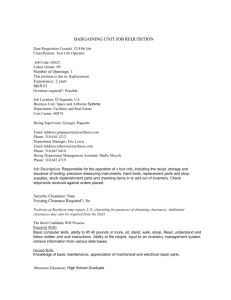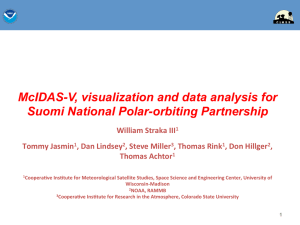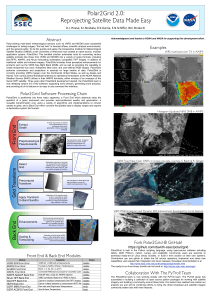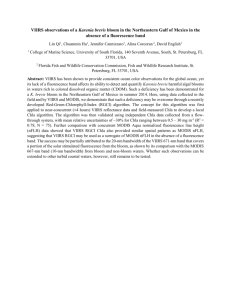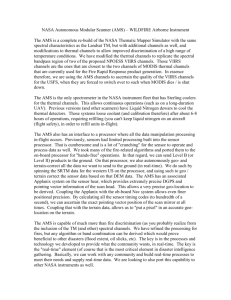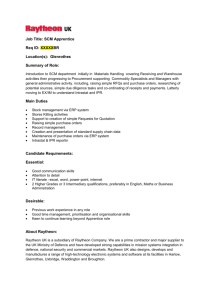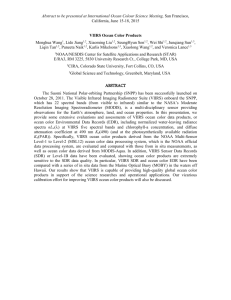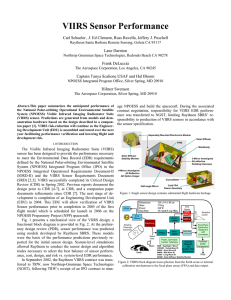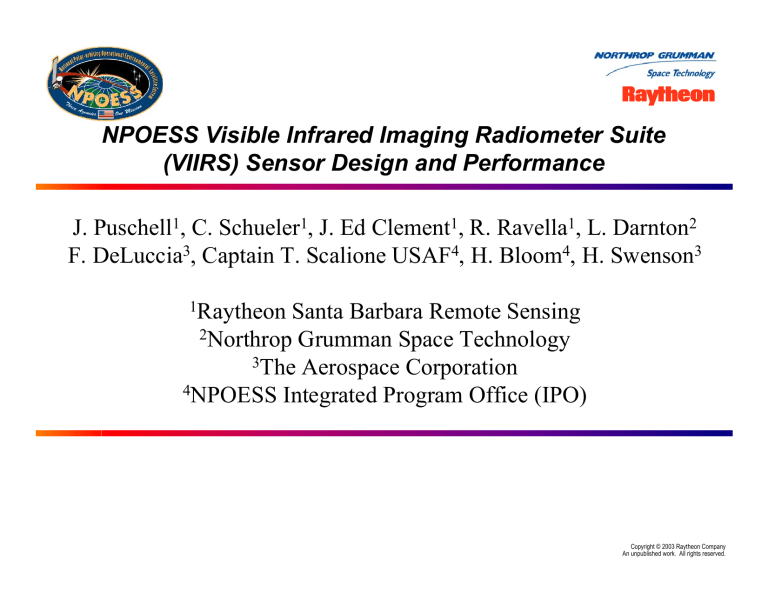
NPOESS Visible Infrared Imaging Radiometer Suite
(VIIRS) Sensor Design and Performance
J. Puschell1, C. Schueler1, J. Ed Clement1, R. Ravella1, L. Darnton2
F. DeLuccia3, Captain T. Scalione USAF4, H. Bloom4, H. Swenson3
1Raytheon
Santa Barbara Remote Sensing
2Northrop Grumman Space Technology
3The Aerospace Corporation
4NPOESS Integrated Program Office (IPO)
Copyright © 2003 Raytheon Company
An unpublished work. All rights reserved.
VIIRS System to Provide Excellent
Environmental Data Records (EDRs)
Imagery (with four ARRs)
Sea Surface Temp
Aerosol Optical Thickness
Aerosol Particle Size
Suspended Matter
Cloud Cover/Layers
Cloud Effective Particle Size
Cloud Optical Thickness
Cloud Top Height
Cloud Top Pressure
Cloud Top Temperature
Albedo
Land Surface Temperature
Vegetation Index
Snow Cover/Depth
Surface Type (ST)l
Fresh Water Ice(Sea Ice ARR)
Ice Surface Temperature
Ocean Color/Chlorophyll
Sea Ice Characterization
Active Fires (ST ARR)
Precipitable Water
Cloud Base Height
Net Heat Flux
Soil Moisture
IORD/TRD Threshold
IA
IIA
IIB
IIIB
IORD/TRD Objective
• VIIRS System Design based on integrated Sensor and Algorithms
• Engineering Development Unit (EDU) approaching integration
• EDR Science Algorithms developed, documented, and publicly released by
Raytheon Technical Services Company (RTSC) Information Technology
and Scientific Services (ITSS)
Copyright © 2003 Raytheon Company
An unpublished work. All rights reserved.
VIIRS Performance
Verified by Hardware & Testbed
Auxiliary
Auxiliary &
&
Ancillary
Ancillary
data
data
On-Board
On-Board
Calibrators
Calibrators
VIIRS System
Imagery
Imagery
Ocean
Ocean
TOA*
TOA*
Scene
Scene
Radiance
Radiance
*Top of
Atmosphere
Rotating
Rotating
Telescope
Telescope
Aft
Aft Optics
Optics
/FPAs
/FPAs
RDR
RDR
ProcProcessor
essor
Cooler
Cooler
Sensor: (VIIRS Subsystem)
SDR
SDR
Processing
Processing
Clouds
Clouds
Land
Surface
Surface Land
Temp.
Temp.
Snow/
Snow/
Aerosols
Aerosols
Ice
Ice
Algorithms: (VIIRS Subsystem)
• EDRs drive algorithm and raw sensor data requirements
Closed
the
Loop!
• Sensor specification derived from EDRs with testbed
• Sensor performance verified by hardware risk-reduction
demonstrations and analyses
• EDR performance verified by testbed with sensor models
Copyright © 2003 Raytheon Company
An unpublished work. All rights reserved.
VIIRS Sensor Performance
Defined by Sensor Specification
Sensor Performance Requirements
Scan
56.26o
Spectral
Band center
40 rpm
Spatial
GIFOV
HSI
Bandwidth
Out-ofband
response
Tolerances
Radiometric
Typical Radiance
(Ltyp)
Calibration
Other
Pre-launch
Uniformity
On-orbit
Linearity
Dynamic range
Stability
MTF
SNR
Crosstalk
Stray light
Alignment
Pointing
Registration
In this presentation
In VIIRS specification
• Northrop-Grumman Space Technology (NGST) contract to Raytheon Santa
Barbara Remote Sensing (SBRS) based on sensor specification
• NPOESS Integrated Program Office (IPO) contract to NGST based on
system specification including EDR performance
Copyright © 2003 Raytheon Company
An unpublished work. All rights reserved.
Photons to Digital Data: VIIRS
Architecture Stable Since PDR
SDSM
Sun
Dimensions:
Mass:
Power:
Data Rate:
134 x 141 x 85 cm
275 kg
240 W
10.5 peak/8 avg Mbps
Solar
Diffuser
BeamBeamsplitter
splitter
FPA
Dewar
SWIR/
MWIR (8)
LWIR (4)
Blackbody
Rotating
Telescope
Assembly
HAM
Imager
Space
Space
View
View
Moon
Earth
Beamsplitter
Power, Command,
Control, Telemetry
DNB VisNIR SWIR MWIR LWIR HAM SDSM -
Radiative Cooler/
Earth Shield
DNB/VNIR
(10 bands)
Ground
Support
and
System Test
Equipment
Day/Night “Band”
Visible/Near IR
Short Wave IR
Mid Wave IR
Long Wave IR
Half Angle Mirror
Solar Diffuser Stability Monitor
Focal Plane
Electronics
Readout &
A/D
Conversion
Formatter
Buffer
Compression
Data
Copyright © 2003 Raytheon Company
An unpublished work. All rights reserved.
VIIRS Post-CDR Refinements
Being Verified in EDU*
Electronics module (EM) &
cables refined to minimize EMI
MODIS-heritage
blackbody
relocated to
minimize Earth
shine
3-Mirror Anastigmat
Rotating telescope
refined to eliminate
modulated instrument
background (MIB)
MODIS-heritage
Solar Diffuser
Stability Monitor
refined to improve
performance
4-mirror anastigmat
All-reflective
Aft optics imager
• Constant-speed rotating telescope
• Simple all-reflective diamond point
turned bolt-together optics
• Proven emissive/reflective calibration
MODIS-heritage Solar
Diffuser screen
redesigned to
minimize solar
modulation
Passive
Cryoradiator
Cold FPA
Dewar Assembly
Copyright © 2003 Raytheon Company
An unpublished work. All rights reserved.
VIIRS Compact, All Reflective
Non-Image Rotating Optical Design
Key post-CDR redesign:
Moved aperture stop from
primary mirror to just aft of
HAM to keep source of
detected rays within primary
mirror, mitigating MIB
HAM rotates at half RTA speed
in same direction to eliminate
image rotation
Rotating Telescope
Assembly (RTA)
VNIR/DNB FPA
SWIR/MWIR
& LWIR Dewar
Half Angle Mirror (HAM)
FMA Imager
Copyright © 2003 Raytheon Company
An unpublished work. All rights reserved.
Follow the Photon!
Copyright © 2003 Raytheon Company
An unpublished work. All rights reserved.
Sensor Models Being Verified by
Engineering Development Unit (EDU) Tests
Solar Diffuser
Model Description
Polarization Performance
D
Sequential Ray Trace
E
Non-sequential Ray Trace
F
Thin Films Design and
Performance
G
Structural Design and
Performance
H
Thermal Design and
Performance
I
Electronics Simulation
Rotating
Telescope: A, B
Half-Angle Mirror: I
1
2
1
3
4
2
5
6
3
7
8
4
9
10
5
11
12
6
13
14
7
15
16
8
17
18
9
19
20
10 SCAN
21
22
11
23
24
12
25
26
13
27
28
14
29
30
15
31
32
16
A B C DE F GH I
A
16
15
14
10
9
8
7
6
5
4
3
2
1
B
C
D
E
32
31
30
29
28
27
26
25
24
23
22
21
20
19
18
17
16
15
14
13
12
11
10
9
8
7
6
5
4
3
2
1
C ABLE SID E
F
G
H
A
SC A N
B
C
32
31
30
29
28
27
26
25
24
23
22
21
20
19
18
17
16
15
14
13
12
11
10
9
8
7
6
5
4
3
2
1
D
FPAs &
EM:
A,B, H, I
E
16
15
14
13
12
11
10
9
8
SC A N
TR AC K
Focal Plane Array (FPA)
Performance
12
11
TRA C K
J
13
Aft Optics: A, B
Stage 1b
C
All
Optics:
C,D,E,F,H
On-Board Calibration Mechanisms: A
Mux 1a Mux 1b
Mux 2aMux 2b
Mux 3aMux 3b
Modulation Transfer
Function (MTF)
Stage 1a
B
Blackbody
Reference
Mux 1a Mux 1b
Signal to Noise Ratio (SNR)
TRACK
A
CABLE SIDE
Legend
Solar Diffuser
Stability Monitor
7
6
5
4
3
2
1
C A B LE SID E
Mainframe: G, H
Focal Planes Electronics
(FPAs): J Module (EM): G
Copyright © 2003 Raytheon Company
An unpublished work. All rights reserved.
Spectral, Spatial & Radiometric
Attributes of 22 VIIRS Bands
Silicon PIN Diodes
VIS/NIR FPA
PV HgCdTe (HCT)
PV HCT
Cloud Particle Size
Cirrus/Cloud Cover
Binary Snow Map
Snow Fraction
Clouds
Imagery Clouds
SST
SST
Fires
Single
Single
Single
Single
Single
Single
Single
Low
High
5.4
6
7.3
7.3
0.12
270 K
270 K
300 K
380 K
74
83
6.0
342
10
2.500
0.396
0.107
0.423
98
155
97
439
17
0.486
0.218
0.063
0.334
32%
88%
1523%
28%
66%
415%
82%
69%
27%
1.60 x 1.58
1.60 x 1.58
0.80 x 0.789
1.60 x 1.58
Cloud Top Properties
SST
Cloud Imagery
SST
Single
Single
Single
Single
270 K
300 K
210 K
300 K
0.091
0.070
1.500
0.072
0.075
0.038
0.789
0.051
22%
85%
90%
42%
Nadir
0.742 x 0.259
End of Scan
1.60 x 1.58
M2
0.445
0.742 x 0.259
1.60 x 1.58
M3
0.488
0.742 x 0.259
1.60 x 1.58
M4
0.555
0.742 x 0.259
1.60 x 1.58
I1
M5
0.640
0.672
0.371 x 0.387
0.742 x 0.259
0.80 x 0.789
1.60 x 1.58
M6
I2
M7
0.746
0.865
0.865
0.742 x 0.776
0.371 x 0.387
0.742 x 0.259
1.60 x 1.58
0.80 x 0.789
1.60 x 1.58
0.7
0.742 x 0.742
0.742 x 0.742
M8
M9
I3
M10
M11
I4
M12
M13
1.24
1.378
1.61
1.61
2.25
3.74
3.70
4.05
0.742 x 0.776
0.742 x 0.776
0.371 x 0.387
0.742 x 0.776
0.742 x 0.776
0.371 x 0.387
0.742 x 0.776
0.742 x 0.259
M14
M15
I5
M16
8.55
10.763
11.450
12.013
0.742 x 0.776
0.742 x 0.776
0.371 x 0.387
0.742 x 0.776
CCD DNB
S/MWIR
1.60 x 1.58
1.60 x 1.58
0.80 x 0.789
1.60 x 1.58
1.60 x 1.58
0.80 x 0.789
1.60 x 1.58
1.60 x 1.58
M1
Wavelength
(µm)
0.412
Band
No.
LWIR
Ocean Color
Aerosols
Ocean Color
Aerosols
Ocean Color
Aerosols
Ocean Color
Aerosols
Imagery
Ocean Color
Aerosols
Atmospheric Corr'n
NDVI
Ocean Color
Aerosols
Imagery
Signal to Noise Ratio
(dimensionless)
Ltyp or
Ttyp
or NE∆T (Kelvins)
Required Predicted
Margin
Low
44.9
352
441
25%
155
316
807
155%
High
Low
40
380
524
38%
146
409
926
126%
High
32
416
542
30%
Low
123
414
730
76%
High
21
362
455
26%
Low
90
315
638
102%
High
22
119
146
23%
Single
10
242
298
23%
Low
68
360
522
45%
High
9.6
199
239
20%
Single
25
150
225
50%
Single
6.4
215
388
81%
Low
33.4
340
494
45%
High
Var. 6.70E-05
6
5.7
-5%
Horiz Sample Interval
(km Downtrack x Crosstrack)
Driving EDRs
Radiance
Range
Copyright © 2003 Raytheon Company
An unpublished work. All rights reserved.
I
0.74km
DNB
I
0.74km
0.75km
1.2km
1.6km
1.1km
0.75km
M
Fine-Resolution
Imaging ‘I’ Bands
0.74km
Day-Night
Band ‘DNB’
M
DNB
0.74km
DNB
0.74km
I
0.74km
Finer Sampling, Spatial
Resolution & Better Sensitivity
M
Moderate-Resolution
(“Radiometric”) ‘M’ Bands
1.6km
SNR predicted and specified at worst-case edge of scan:
~60% better nadir SNR and finer spatial resolution
Copyright © 2003 Raytheon Company
An unpublished work. All rights reserved.
VIIRS Provides Operational Data
Continuity in Many Areas,
Including Ocean Color*
Commercial &
Research
Research
Operational
SeaWiFS
(1997)
NASA EOS MODIS
(1999)
NPOESS VIIRS
(2006 NPP)
• 5 year mission –
aproaching 6 years
• Verified ocean color
benefits
• Eight bands
• 5 year life
• Nine ocean color
bands
• Ocean color one of
many applications
• 7 year life
• Seven ocean color
bands
• Ocean color supports
other VIIRS EDRs
*With VIIRS improvements: e.g., dual-gain, finer spatial resolution, better sensitivity, etc.
Copyright © 2003 Raytheon Company
An unpublished work. All rights reserved.
VIIRS Model Predicts Excellent
Polarization Sensitivity Margin
VIIRS
Band
Bandcenter
(nm)
-45
degrees
412
Polarization
Specification
(%)
3.0
M1
Zero
+45
degrees degrees
1.30
2.00
2.90
M4
555
2.5
0.50
0.30
0.60
I2 & M7
865
3.0
0.70
0.04
0.02
Image courtesy the SeaWiFS Project, NASA/Goddard Space Flight Center and ORBIMAGE
Copyright © 2003 Raytheon Company
An unpublished work. All rights reserved.
Detailed Thermal Modeling Predicts
On-orbit Temperature Variations
Thermal model 1730 orbit, hot
282
• Detailed calibration model
uses results to predict
emissive band radiometric
accuracy: Model predicts
specification margin in all
bands
281
280
Temperature, K
• Detailed VIIRS thermal
model predicts sensor
structure and optics
element temperatures vs.
orbit and time: Greatest
variations in 1730
(terminator) orbit
279
278
277
276
0
20 40
60 80 100 120 140 160 180 200 220
Time, minutes
HAM cavity (1092)
HAM cavity (1041)
HAM
HAM cavity (1042)
Aft optics
HAM cavity (1048)
Copyright © 2003 Raytheon Company
An unpublished work. All rights reserved.
Detailed SST-band Error Budget
with On-orbit Temperature Variations
Parameter
VIIRS Center Wavelength (µm)
3.70
4.05
8.55
10.76
12.01
Ttypical (K)
270
300
270
300
300
Temperature knowledge effect (%)
0.32
0.24
0.14
0.09
0.08
Wavelength knowledge effect (%)
0.20
0.20
0.04
0.03
0.04
Integrated out-of-band effect (%)
0.30
0.30
0.20
0.10
0.10
Response vs. scan angle knowledge (%)
0.20
0.20
0.60
0.20
0.20
Response vs. scan angle pedestal knowledge
0.20
0.20
0.60
0.20
0.20
Emittance knowledge (%)
0.20
0.20
0.20
0.20
0.20
Electronic crosstalk (%)
0.20
0.20
0.20
0.20
0.20
Ghosting (%)
0.24
0.24
0.24
0.24
0.24
Polarization knowledge effect (%)
0.01
0.01
0.10
0.10
0.10
Earthshine effect (%) (Tearth=343K)
0.029
0.025
0.009
0.008
0.007
Solar diffuser screen emission (%) (Tinst=285K)
0.0293
0.0245
0.0091
0.0076
0.0071
Solar diffuser Sunlight Scatter (%)
0.128
0.110
0.047
0.041
0.038
Blackbody Skin Temp Effect (%) (Tinst=275K)
0.014
0.003
0.0
0.0
0.0
Surround Correction Effect (%) (Tinst=285K)
-0.031
-0.028
-0.013
-0.011
-0.01
Radiometric Calibration Model σ (%)
Allocation Requirement (%)
0.68
0.62
0.55
0.35
0.35
0.7
0.7
0.6
0.4
0.4
MODIS SST image courtesy NASA @http://visibleearth.nasa.gov/data/ev2/ev284_global_SST_sm.jpg
Copyright © 2003 Raytheon Company
An unpublished work. All rights reserved.
Engineering Development Unit (EDU)
Approaching Integration Phase
Cryoradiator Door, 30%
9Focal Plane Interface Electronics
9: completed
or ~%complete
Cryoradiator, 30%
Electronics Module, 70%
Mainframe
Aft Optics Assembly
(including FPAs), 40%
Scan Motor, 50%
Telescope Assembly, 50%
Solar Diffuser Stability Monitor, 80%
9
Half Angle Mirror &
Motor Assembly, 50%
Nadir Radiator Panel
9
Solar Diffuser
9
9
Blackbody
Nadir Aperture Doors, 30%
Copyright © 2003 Raytheon Company
An unpublished work. All rights reserved.
• All EDU FPAs assembled and tested, including
detectors & read-out integrated circuits (ROICs)
• S/MWIR & LWIR FPAs: Photovoltaic (PV) HgCdTe
with integrated “Microlens” technology to reduce
background noise
• All PV HgCdTe allows LWIR time-delay and
integration (TDI) and lowers crosstalk
• Optical alignment of all FPAs provides optimum
band-band registration
DNB
C
D
E
15
16
F
G
H
32
31
30
29
28
27
26
25
24
23
22
21
20
19
18
17
16
15
14
13
12
11
10
9
8
7
6
5
4
3
2
1
15
14
13
12
11
10
8
7
6
5
4
3
2
1
SCAN
TR AC K
9
SW/MWIR
C
D
E
16
15
LWIR
14
13
12
11
10
8
7
SC AN
TR AC K
9
3.00E+12
2.00E+12
-2.500
-2.700
-2.900
-3.100
-3.300
31
29
25
27
23
21
19
17
-3.500
15
1.00E+12
13
2
9
3
11
4
7
5
5
6
1
B
7.00E+12
6.00E+12
5.00E+12
4.00E+12
3
A
32
31
30
29
28
27
26
25
24
23
22
21
20
19
18
17
16
15
14
13
12
11
10
9
8
7
6
5
4
3
2
1
Band I5 DC Uniformity @ Qtyp
Band I5 Noise Equivalent Irradiance
C AB LE SID E
1
3
5
7
9
11
13
15
17
19
21
23
25
27
29
31
B
VNIR
SCAN
NEI, ph/cm^2-s
A
16
1
2
3
4
5
6
7
8
9
10
11
12
13
14
TRACK
CABLE SIDE
1
2
3
4
5
6
7
8
9
10
11
12
13
14
15
16
17
18
19
20
21
22
23
24
25
26
27
28
29
30
31
32
A B C D E F G H I
Signal Voltage, V
Mux 1a
Mux 1a
Mux 2a
Mux 3a
Stage 1a
Stage 1b
Mux 1b
Mux 2b
Mux 3b
Mux 1b
EDU Focal Planes
Verified Design
1
C AB LE SID E
Pixel Number
Pixel Number
Copyright © 2003 Raytheon Company
An unpublished work. All rights reserved.
EDU Testing Lowers Risk
for Flight Unit Integration & Test
Software, Documentation,
and Engineering Analysis
Engineering Development Unit
EDU
Lessons
Learned
• Calibration and Test
• Performance Assessments
Ground Support Equipment
Shipping/
Storage
First Flight Unit
• Integration
• Calibration and Test
• Performance Assessments
96-02-085
Flight
Instruments
NPP model (2005)
C1 model (2006)
Copyright © 2003 Raytheon Company
An unpublished work. All rights reserved.
VIIRS on-track to EDU Integration
& NPP Flight Unit Development
• National Polar-orbiting Operational Environmental Satellite
(NPOESS) Visible Infrared Imaging Radiometer Suite (VIIRS)
approaching Engineering Development Unit (EDU) integration
– Several design refinements lowered EDU and flight unit
development and test risks
– Principal post-CDR optics design change to correct
modulated instrument background (MIB) approved
– Sensor specified for excellent EDR performance: Refined
design offers margin to sensor specification
– Detailed quantitative sensor performance modeling
completed and partially verified by EDU hardware tests
– Remaining EDU fabrication and testing will verify models or
identify corrective action
• First flight unit for NPOESS Preparatory Project (NPP) scheduled
for completion in 2005 for 2006 launch
• Second flight unit for NPOESS initial operational launch in 2130
orbit scheduled for completion in 2006 for 2009 launch
Copyright © 2003 Raytheon Company
An unpublished work. All rights reserved.

